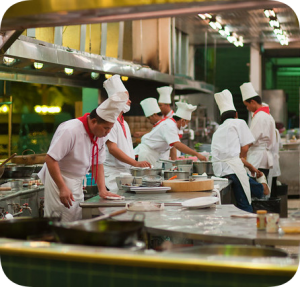 In 2017 Ricky Lopez opened a Top Round franchise in San Francisco’s Mission District. With all sorts of well-established competition in the area already, the chef and entrepreneur says that his roast beef business lost tens of thousands of dollars in its first eight months. Then last year a representative from Uber Eats informed Lopez that his area had a high demand for burgers and ice cream that was going unmet. To take advantage of this opportunity, the food delivery company suggested that Lopez open a few “virtual” restaurants that could increase his sales by as much as 50 percent.
In 2017 Ricky Lopez opened a Top Round franchise in San Francisco’s Mission District. With all sorts of well-established competition in the area already, the chef and entrepreneur says that his roast beef business lost tens of thousands of dollars in its first eight months. Then last year a representative from Uber Eats informed Lopez that his area had a high demand for burgers and ice cream that was going unmet. To take advantage of this opportunity, the food delivery company suggested that Lopez open a few “virtual” restaurants that could increase his sales by as much as 50 percent.
Soon Lopez had three new brands operating out of his Top Round kitchen: a friend chicken joint, a burger place, and a dessert business. Of course, none of these establishments had physical storefronts. Instead, they are available only through the Uber Eats app. With more and more consumers opting to order delivery, Uber Eats encourages entrepreneurs like Lopez to use their existing kitchens to create virtual restaurants. The company even analyzes neighborhoods to find out what sort of cuisines are underrepresented. And although it doesn’t help entrepreneurs launch these new businesses, the potential rewards for starting an online-only operation can be great. “Delivery used to be maybe a quarter of my business,” said Lopez. “Now it’s about 75 percent of it.”
To meet the increasing demand for delivery, some entrepreneurs are even opening “ghost” kitchens that have no retail presence at all. While virtual restaurants like Lopez’s operate out of existing storefronts, ghost kitchens only pump out delivery orders. For instance, the Los Angeles startup CloudKitchens leases cooking space to chains like Sweetgreen for their delivery-only operations. But not every business is benefiting from the delivery boom. Ironically, restaurants that once relied heavily on delivery are suffering as consumers move to apps. For pizza guy Paul Geffner, most of the revenue from his five Bay Area pizzerias came from customers ordering directly from his business. People eventually switched to delivery apps like Uber Eats and Grubhub, however, which charge restaurants commissions ranging from 15 to 30 percent for each order. “We saw a direct correlation between the delivery services and the reduction of our income,” Mr. Geffner said. “It was like death by a thousand cuts.” As a result, Geffner recently closed two of his pizzerias.
Questions:
- Why are some entrepreneurs starting to open “virtual” restaurants?
- What are the advantages and disadvantages of food delivery apps like Uber Eats and Grubhub?
Source: Mike Isaac and David Yaffe-Bellany, “The Rise of the Virtual Restaurant,” The New York Times, August 14, 2019. Photo by Dennis Wong.
